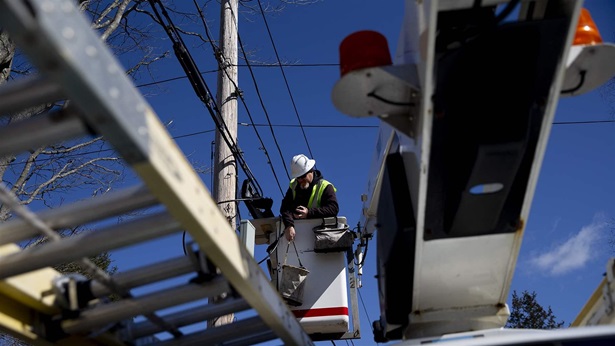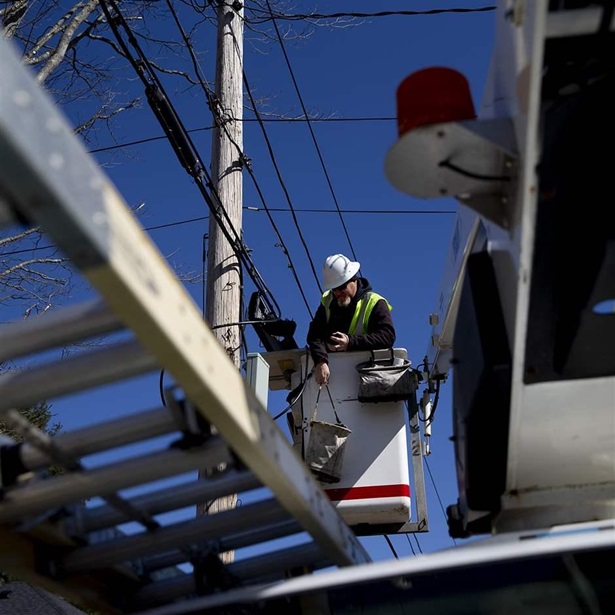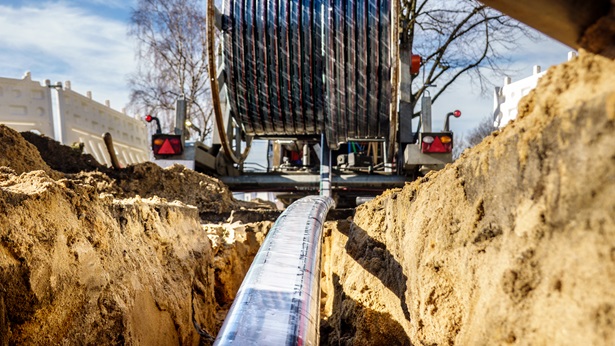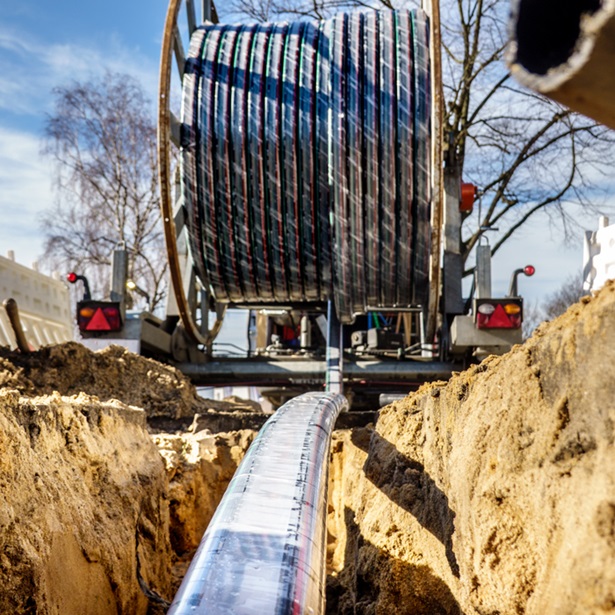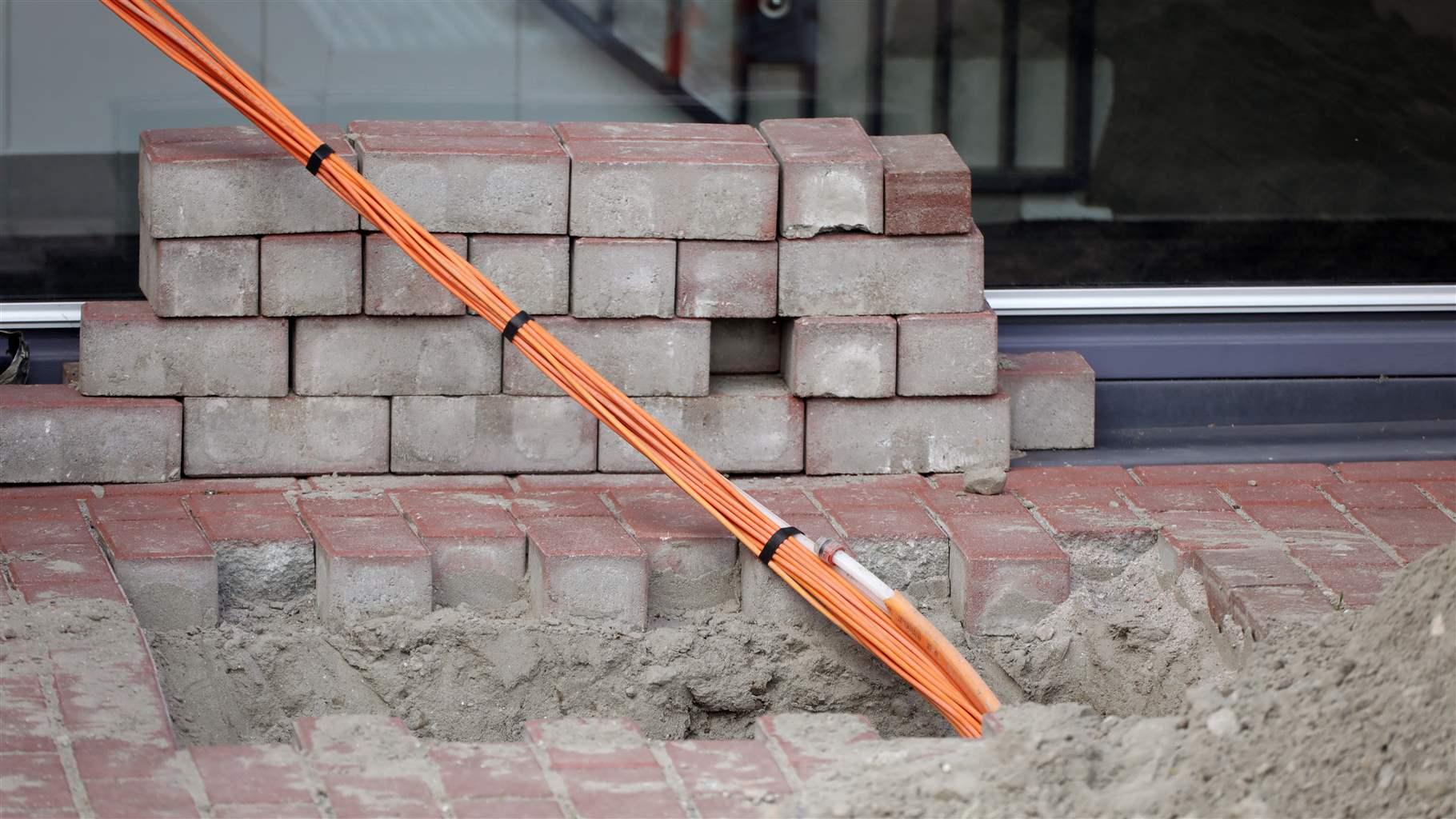How 8 States Are Using Line Extension Programs to Connect Unserved Residents to Broadband
Initiatives bridge the gaps from individual homes and businesses to existing networks
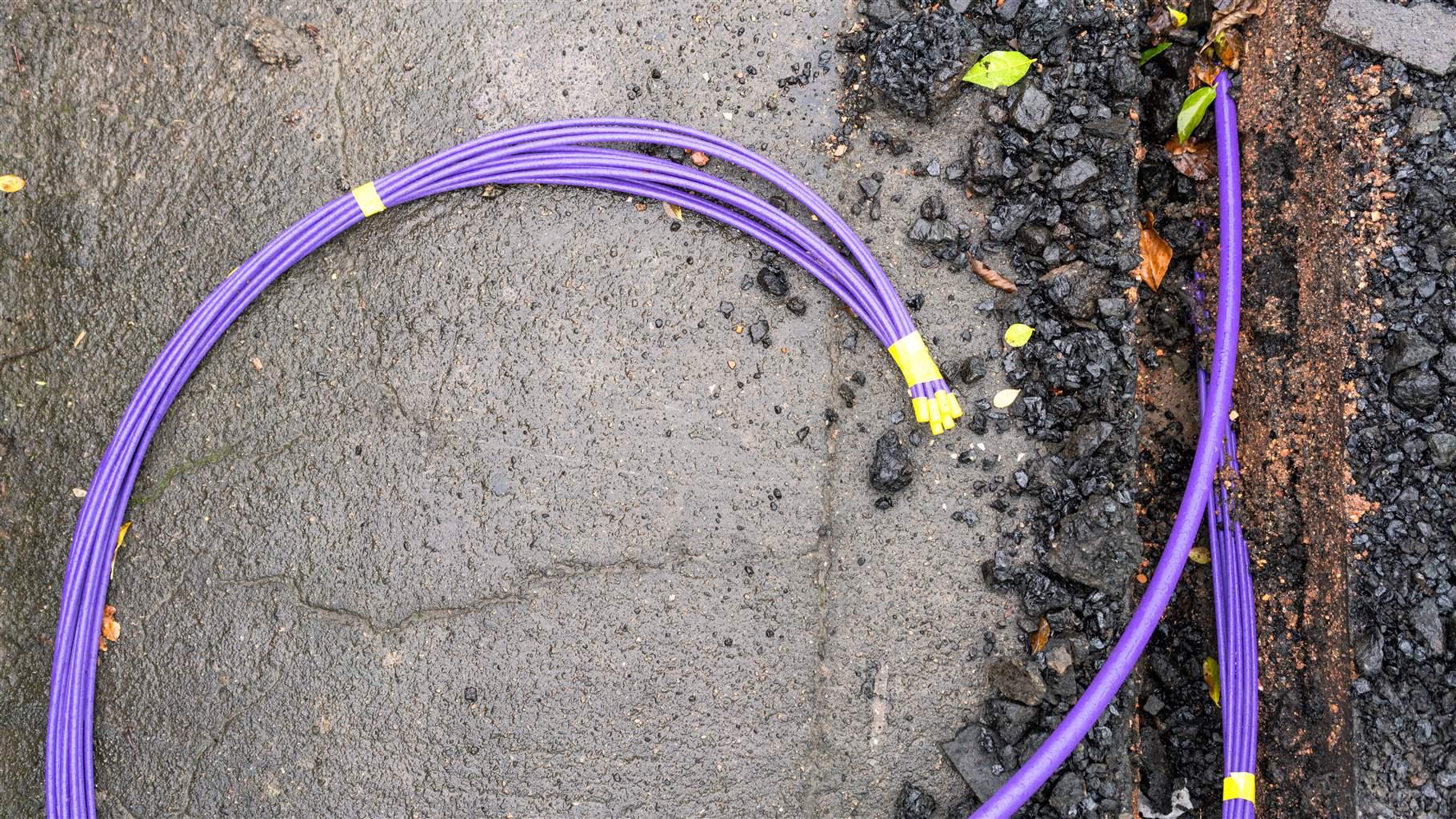
Overview
Over more than a decade, states have invested billions of dollars to extend broadband service to areas without high-speed internet. Those efforts have made significant impacts, reaching many large, previously unserved areas using grant programs and federal funding. But now states are increasingly grappling with how to identify and connect unserved homes and businesses that are just out of reach of nearby last-mile infrastructure—the segment of a broadband network that connects a local internet service provider (ISP) to a customer—in areas that are otherwise served.
Properties may not be connected to existing infrastructure for a variety of reasons. For instance, they may be set far back from the street, or previous owners may have denied service providers access to the properties to perform network installations. As a result, individual property owners in otherwise connected areas find themselves without service and responsible for building the final run of cable or fiber line from existing broadband infrastructure to their home or business. These extensions often cost thousands of dollars, which can be prohibitive, especially for low- and moderate-income households.
Eight states—California, Indiana, Maine, Minnesota, Pennsylvania, Vermont, Virginia, and West Virginia—have sought to address this problem using line extension programs. These programs can provide not only a highly accurate mechanism for identifying these scattered unserved locations at the address level but also grants to cover the construction expenses of connecting those properties.
Although these programs all aim to expand broadband access to unserved residents, each of these states has taken a slightly different approach. Some have set speed and affordability standards to ensure that ISPs deliver quality service to grant-funded addresses and that low-income households have affordable broadband options. Others have established household eligibility requirements to direct public funding to only those who need it most.
States also have used different funding sources to finance their line extension programs. A few have appropriated state funds, and others have tapped the significant federal dollars available from the Coronavirus Aid, Relief, and Economic Security (CARES) Act, the $350 billion Coronavirus State and Local Fiscal Recovery Funds (SLFRF) program, and the $10 billion Capital Projects Fund (CPF). With additional federal allocations becoming available soon through the Broadband Equity, Access, and Deployment (BEAD) Program, line extension programs offer states another tool they can consider using to close the digital divide.
This brief looks at how these eight states have deployed and funded line extension programs and how other states might similarly use this strategy to reach their remaining unserved properties.
State-funded line extension models
California
California was the first state to create a line extension program. In 2017, the Legislature passed AB 1665, which established the Line Extension Program (LEP) as a pilot project to support broadband access for low-income households under the California Advanced Services Fund and allotted $5 million to the program.
The California Public Utilities Commission (CPUC), which administers the LEP, released program guidelines in 2019. Under the rules, households that qualify for discounted phone and energy services through the California LifeLine or California Alternate Rates for Energy programs are eligible for LEP funding. Households can apply for grants themselves or have representatives, such as ISPs, apply on their behalf.
ISPs install the line extensions and receive payments, which are capped at $500 per household for wireless projects and $9,300 per household for wirelines, directly from the state. Providers must complete the line extensions within 12 months, offer speeds of at least 100 Megabits per second (Mbps) for downloads and 20 Mbps for uploads (often expressed as 100/20 Mbps), and inform households of any low-income service options available.
To date, CPUC has approved just three projects under LEP for more than $300,000 of funding. And although the program has successfully connected many low-income residents, it has been underutilized, with almost $4.7 million of the funding still unused.
Line Extension Grant Connects a Farmworker Housing Facility to Free Broadband
In 2020, only 13 of the 66 locations in the San Jerardo Cooperative—a multifamily housing facility for low-income farmworkers in Monterey County, California—had internet service. With roughly 350 residents during the harvest season, including about 70 students, and an average adult income of $14,359 annually, the San Jerardo community needed broadband to connect to vital services, such as schools and telehealth, during the COVID-19 pandemic, but many residents could not afford internet access.
At the time, just one wireless provider served the immediate area, and at $155.95 a month for 10 Mbps service, the available connections were neither high-speed nor affordable. Because most students living in the cooperative did not have internet at home, the general manager, Horacio Amezquita, allowed them to use his office internet to access their schoolwork online, but even that service was unreliable and many students struggled to complete their course obligations.
Amezquita discussed the San Jerardo residents’ lack of internet access with then-CPUC Commissioner Martha Guzman Aceves, who then raised the issue with the Central Coast Broadband Consortium, a group of local government agencies, community groups, and private companies dedicated to expanding broadband access in the region. Cruzio, a local ISP and consortium member that had recently connected a nearby farmworker housing facility, the Buena Vista Migrant Center, to free high-speed internet, applied to the LEP for funding to connect San Jerardo to existing fiber lines running between Santa Cruz and Soledad.
In September 2021, the CPUC approved Cruzio’s application and awarded $292,548 to connect the 53 unserved units. The application also noted that although the project did not meet the LEP’s procedural requirement that “individual households or property owners” receive the grants, it did fulfill the statutory requirements and purpose, and that in light of the pandemic and the oversubscription of the state’s broadband fund for unserved areas, the LEP was probably the best solution for meeting the San Jerardo community’s needs. As part of the final grant approval, Cruzio agreed to provide 100 Mbps symmetrical service (that is, for uploads and downloads) to San Jerardo residents free for the first five years and at a potential maximum monthly rate of $15 thereafter.
Cruzio finished construction on the project in September 2022 and held a ribbon-cutting ceremony to mark the occasion. All units and two communal spaces in the housing cooperative now have connections to broadband infrastructure, and all residents are subscribed to free high-speed service.
Indiana
In 2021, Indiana passed SB 377, creating the Indiana Connectivity Program (ICP) within the Office of Community and Rural Affairs (OCRA). The program, which receives funding from the state’s $270 million broadband infrastructure grant, identifies unserved properties near existing broadband infrastructure and provides competitive grants to ISPs to connect these locations. Under the ICP, grant recipients can receive up to $25,000 per line extension and $4,800 per premise. Since its launch, the ICP has awarded $4.4 million to connect 978 properties across the state.
SB 377 outlined ICP’s funding guidelines—which allow residents and ISPs to engage in the competitive grant process—and charged OCRA with soliciting ISPs to participate in the program. The legislation also required OCRA to create an online portal where state residents can submit home and business addresses that lack access to broadband speeds of at least 25/3 Mbps. Every three months, OCRA must post these addresses online and notify participating ISPs that the list is available.
Upon receiving OCRA’s list, providers have 10 business days to challenge addresses on the list where their broadband service is already available. Then, after the challenge period, OCRA must solicit bids from participating ISPs to provide service of at least 50/5 Mbps to any unchallenged addresses on the list. ISPs then have 60 days to submit their bids, which must include line extension proposals, how much money they are willing to contribute to the project, and estimates of the state’s portion of construction expenses.
For each address providers bid on, OCRA selects the proposal with the lowest cost and releases funding to the ISPs upon completion of the line extension construction. The ICP’s funding process enables ISPs to bid on multiple addresses and similarly encourages multiple providers to compete for each location. This approach drives down the price of connecting individual households, which allows OCRA to extend service to the highest number of homes at the lowest cost to the state.
Federally funded line extension programs
The federal SLFRF and CPF funding programs are provided under the American Rescue Plan Act (ARPA), which includes speed and affordability guidelines that are typically higher than what state-supported grants have previously required. And state line extension programs that use these funds must set standards at or above the federal benchmarks. ARPA requires that funded projects deliver broadband speeds of at least 100 Mbps symmetrical, unless that technology is impractical due to an area’s topography or associated costs, and participate in the Affordable Connectivity Program (ACP), a federal broadband subsidy for low-income households. Although states retain the flexibility to tailor ARPA-funded programs to meet their own broadband priorities, these standards ensure that end users will have access to reliable and affordable service.
Vermont
In its 2020 CARES Act appropriation bill, Vermont created and allocated up to $2 million to fund the Line Extension Customer Assistance Program (LECAP). The state based the new program on its existing cable line extension program, which enables residents to request connections to nearby cable television infrastructure and to share the construction costs with providers. Under LECAP, residents without access to broadband service of at least 25/3 Mbps could receive grants of up to $3,000 to connect their properties to the necessary infrastructure.
After Congress passed ARPA in 2021, Vermont appropriated another $1.6 million of that money for LECAP but did not provide any further funding. Although the program spanned only two years, it awarded more than $1.35 million to connect over 800 unserved residents in that time.
Maine
In 2022, the Maine Connectivity Authority (MCA), a quasi-governmental agency that oversees broadband programming in the state, announced an initiative to leverage $150 million in federal ARPA dollars to connect more than 30,000 locations in rural areas, including an investment of $20 million in CPF funds for the Reach Me Line Extension Incentives program.
Reach Me uses a collaborative approach in which the MCA and eligible ISPs work together to design line extension routes. The MCA first identified areas of the state that are eligible for program funding. Then, in October 2022, it issued a request for qualifications, and ISPs interested in participating in the program replied with labor and material costs, confirmation that they have existing broadband networks in the state, and other information. Based on those responses, the MCA will invite qualified ISPs to identify the specific projects they are interested in and offer input on what those projects will require. Participating ISPs must complete construction by 2025, are encouraged to deploy fiber, and must contribute a minimum of $700 per location along line extension routes.
Funded projects must meet not only the service and affordability criteria required by the CPF, but also Reach Me program requirements for specific service tiers to ensure that residents receive affordable high-speed internet. In particular, participating ISPs must offer customers enrolled in the ACP service of at least 50/10 Mbps at a price of $30 or less per month, which would be fully covered by the ACP subsidy, and the price of 100/20 Mbps service must not exceed the federal “reasonable comparability benchmark” determined by the Federal Communications Commission’s annual Urban Rate Survey.
Virginia
In 2021, the Virginia Legislature appropriated $479 million of ARPA funding to the state’s Department of Housing and Community Development (DHCD) for broadband expansion. Of that sum, lawmakers dedicated $8 million to the Line Extension Customer Assistance Program (LECAP) to support expanding existing broadband networks to low- and moderate-income residents. DHCD determines families’ eligibility for line extensions grants based on relative income levels in each part of the state. To qualify for LECAP, households must have annual incomes that either are $89,066 or less or fall below 120% of the median for their ZIP code up to a maximum household income of $133,598.99 a year. Eligible households can apply to LECAP themselves or through referrals from either ISPs or local health care providers. Applicants must submit income documentation, reside primarily at the location for which they are requesting an extension, agree to sign up for broadband service when it becomes available, and apply for the federal ACP subsidy if they qualify for it.
To encourage ISPs to participate in the program, DHCD released a request for information and to date has approved 14 ISPs. Under LECAP’s rules, DHCD will pay up to $10 per linear foot for overhead infrastructure and up to $15 per linear foot for underground builds. Although wireless internet providers can also receive line extension funding, the state considers applications involving their services on a case-by-case basis.
In its first round of funding, LECAP received six applications requesting a total of $22.7 million to connect 3,226 locations. And in 2022, the Legislature appropriated another $8 million of ARPA dollars to LECAP.
Minnesota
In a 2022 appropriations bill, the Minnesota Legislature tasked the state’s Office of Broadband Development (OBD) with establishing a line extension program and allocated $15 million of CPF funding for the effort. Shortly after, the office created the Broadband Line Extension Connection Program to bring existing broadband facilities to addresses without wired broadband service of at least 25/3 Mbps.
Minnesota’s program, much like the one in Indiana, invites residents and ISPs to participate in a competitive grant process, solicits their input on unserved locations, and awards grants using a reverse auction model that allows multiple providers to bid on the same addresses. This funding process encourages competition among ISPs, helping the state’s broadband office connect the most addresses at the lowest cost.
The program’s authorizing legislation required the OBD to create a portal on its website—as well as a paper form option—to enable residents to submit unserved home and business addresses. Every six months, the OBD emails the list of submitted addresses to ISPs, who then have 10 days to challenge any locations on the list where they already offer service. For addresses that are successfully challenged, the broadband office notifies the people who submitted those addresses about the ISPs that offer service at their locations and any price-reduction programs they may be eligible for. The program caps grant awards at $25,000 per line extension. To date, the program has received over 2,100 applications from households and businesses across the state.
West Virginia
In October 2021, West Virginia Governor Jim Justice announced his plan to invest a billion dollars of state and federal funding in various broadband connectivity initiatives, including the Line Extension Advancement and Development (LEAD) program, which is funded with $30 million in ARPA dollars.
West Virginia’s line extension program takes a different approach than programs in other states by focusing on large-scale projects rather than on connecting individual addresses. The program encourages eligible ISPs—those with existing fiber or cable networks that deliver speeds of at least 100/20 Mbps and can be expanded to areas without service of at least 25/3 Mbps—to extend their infrastructure to properties on the edge of their existing service territories through projects that include 50 or more addresses.
Additionally, LEAD’s rules do not include an explicit cap for individual award amounts, which offers ISPs flexibility to connect the greatest number of unserved locations at one time. However, proposed project areas cannot contain more than 10% existing customers, and the state may ask applicants to split projects that request more than $5 million. Further, applicants must contribute a minimum of $500 toward construction for each address they connect.
The LEAD program accepted applications from November 2021 to January 2022 and made four award announcements that will support deployment of about 768 miles of fiber to connect 9,337 locations.
Pennsylvania
Pennsylvania’s Broadband Infrastructure Program (BIP) received $200 million from the CPF in April 2023. The state program provides grants for two kinds of broadband projects in unserved areas—line extensions that connect individual addresses and large-scale regional infrastructure build-outs—and operates according to guidelines that are broad enough to work for both project types while also setting a few specific service requirements to ensure that residents receive affordable, reliable service.
Entities that create and operate broadband infrastructure in the state, which include private businesses, nonprofits, municipalities, and economic development organizations, can apply to BIP between May and July 2023 for $500,000 to $10 million grants to connect unserved residents and must contribute at least 25% of the total project costs. The program requires applicants not only to comply with all ARPA requirements, but also to provide universal service in project areas and offer at least one low-cost service option at speeds that can support multiple users simultaneously. These requirements ensure that ISPs do not connect only the most densely populated pockets of unserved areas, which are generally the most profitable, and that each household has access to high-speed internet that can meet telework and remote learning needs.
BIP award decisions will conclude in October 2023, and approved applicants will have until the end of 2026 to complete construction.
Conclusion
Over the past several years, a growing number of states have established line extension programs to bring high-speed internet to unserved locations, driven largely by federal funding available through the CARES Act and ARPA. These programs offer state leaders a way to connect residents who live near existing broadband infrastructure but still need the final stretch of network to get online. As these nascent programs review applications and make award decisions, the outcomes of the early funded projects may determine whether states choose to continue investing in line extensions. As additional federal broadband funding becomes available in the coming months, these programs may provide states with another tool to close the digital divide.


America’s Overdose Crisis
Sign up for our five-email course explaining the overdose crisis in America, the state of treatment access, and ways to improve care
Sign up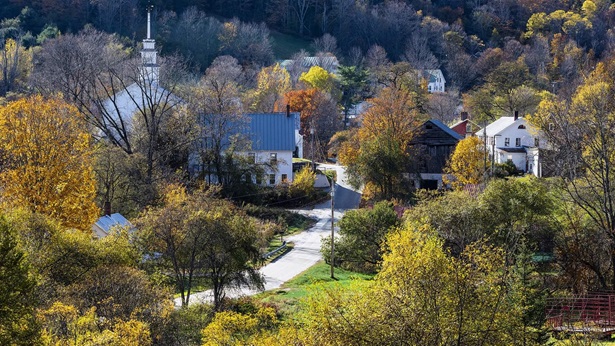
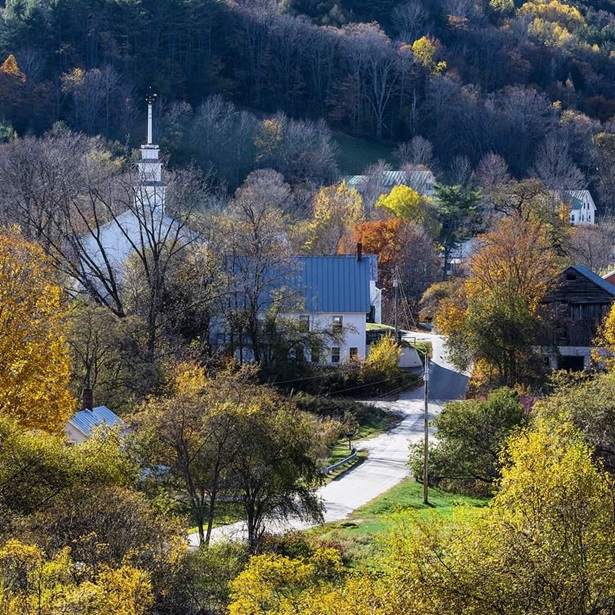
Regional Utility Districts Bring Broadband to Rural Vermont


VA Leverages Electric Utility Infrastructure for Broadband
